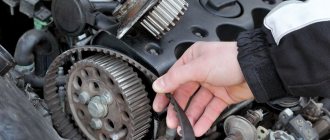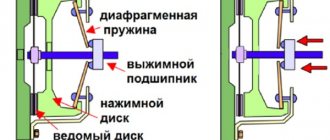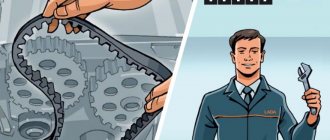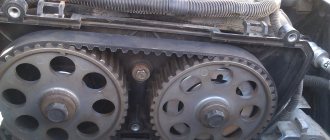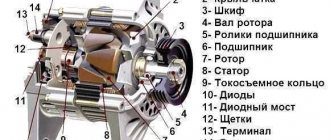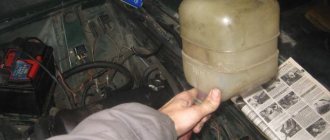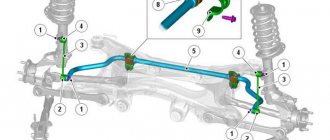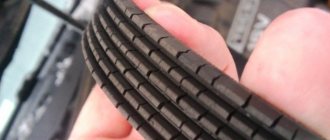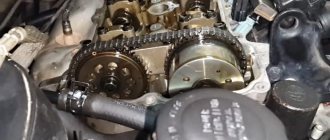The timing belt is one of the main engine parts and is included in the routine maintenance kit. This means that it must be replaced during the appropriate vehicle maintenance intervals. If this operation is not performed in a timely manner, the following engine malfunctions are possible:
- failure to start the internal combustion engine;
- malfunction of the gas distribution mechanism, requiring mandatory replacement of the timing belt, tensioning mechanism (roller, etc.), installation and adjustment of the ignition angle;
- in most cases, it may be necessary to repair the piston and valve group with all the work corresponding to the engine overhaul nomenclature.
It is the last point that brings fear to most car owners. Therefore, when purchasing a used car, every buyer should ask the seller when the timing belt was last replaced. You should not trust the information received 100%. First of all, he might be wrong. Secondly, the seller may not have reliable information. Therefore, after the purchase, it is better to carry out an extraordinary check of the condition of the elements of the gas distribution mechanism and decide on the timing of replacing the timing belt.
Timing belt replacement intervals.
The timing belt in a car engine is for every driver the most important point in the maintenance of their car. What happens when this component in a car breaks? How often should this belt be changed? Is it difficult to replace the timing belt yourself? You friends will get answers to these and other questions in our published material today.
What is a Timing Belt?
This timing belt is a serpentine belt (a belt with special profiles that transmits much more torque than a flat belt drive) that is placed on one side of the engine in a pulley of a specific configuration so that the camshaft and crankshaft operate synchronously. In simple terms, we can say that the timing belt ensures synchronization of the operation of the upper part of the engine (cylinder head, valves) with the lower part of the power unit (crankcase, pistons). Thanks to this belt, the gas distribution mechanism works synchronously in the engines.
Determining the need to replace the timing chain
As the need to replace the chain approaches, it lengthens significantly. A consumable rupture occurs extremely rarely. This is especially true for double-row chains. You can determine the presence of an extension by measuring the consumable. It will be much longer than the new product.
Comparison of new and old chain lengths
When the chain stretches, the tensioner tries to eliminate its elongation. It can be either manual or automatic. The elongation of the chain is determined by the output of its piston.
Tensioner with chain stretched
You can check for chain stretch by pulling it on the camshaft gear. If it rises by a centimeter or more, then there is a risk of the teeth jumping and such a consumable must be replaced.
Stretched camshaft chain and gear
When the timing chain stretches, a number of external symptoms of the need for replacement appear. There is a metallic knock coming from the timing drive side. It is most noticeable on a cold engine after starting. With more severe chain wear, a timing shift occurs. The engine loses power, fuel consumption increases, and the speed becomes unstable.
Modern cars have a self-diagnosis system that receives information from sensors. A symptom of the need to replace the chain is the presence of errors in the operation of the crankshaft and camshaft sensors. You can check for problems using a diagnostic scanner.
Information about errors in the operation of the crankshaft and camshaft
To eliminate errors from the sensors themselves, it is recommended to take oscillograms of the timing belt operation. By counting them, you can see obvious symptoms of the need to replace the timing chain.
Oscillograms of timing belt operation
Does my car have a timing belt?
If your car was manufactured 10 -15 years ago, then its engine is probably equipped with a timing belt. Many automakers currently also use this same belt in the engine timing mechanism. For example, it continues to install timing belts on many of its cars. True, it should be noted here that many automobile companies have already refused to equip their new cars with such a timing belt. Instead, in some and even many car models, automakers began to use just a chain, which is much more durable than this belt. To find out for yourself whether your car has a timing belt, you need to refer to the vehicle’s operating manual or study in detail the schedule of scheduled maintenance of your car.
If you do not have such documentation, then ask this question to an online forum (club), where the owners of the same (as yours) car model will tell you whether a timing belt is installed on your power unit. Also, at the end of our article, you can familiarize yourself in detail with the list of cars (by brand) in which a timing belt is installed, and at the same time you can find out for yourself about the schedule recommended by manufacturers for replacing this belt. You can also find out what can happen if the timing belt in your car suddenly breaks?
After how many thousand kilometers does it need to be changed?
It is impossible to accurately predict the life expectancy of a timing belt, especially if it has already been changed and a non-original mechanism part has been installed. Installing a non-original part is generally quite a risky endeavor, which can lead to unpleasant consequences for the mechanism and the engine as a whole.
When determining the frequency of replacement, you should also take into account the operating conditions of the vehicle. A number of factors affect the life of a timing belt. In addition to the fact that the part is constantly exposed to dynamic loads, temperature changes in the engine compartment, contact with random objects, ingress of liquids, dirt, etc., have an adverse effect. Damage and incorrect operation of other elements of the gas distribution mechanism can also accelerate wear.
When to change the timing belt can be found out from the technical documentation for the vehicle, since for a specific brand of car the frequency of replacement may differ due to design features, as well as the material of the product itself. On average, the timing belt needs to be changed after 50,000 kilometers of a car’s mileage, and no matter what mileage is indicated by the manufacturer, it must be taken into account that this refers to ideal operating conditions. So if the documentation states a figure of 120,000 km, then it can be safely reduced by 30-40,000 km.
For a new domestically produced car, the part usually needs to be replaced after 60,000 km, for an imported car after 70-80,000 km. If the timing belt on the car has already been changed, the timing is reduced to 50,000 and 60-70,000 km, respectively.
When a car was purchased second hand, it is not at all clear how many kilometers later a replacement is needed, whether the part is a factory one or whether the previous owner has already changed it. In addition, it is unknown how and under what conditions the car was operated. If it is not possible to clarify these points, taking into account the mileage, change the belt (if it has not been changed) immediately. When the part has already been replaced, you can travel with it about 30,000 km for a domestic car or 50,000 for an imported one.
In winter, many motorists warm up the car before driving, then the engine and, accordingly, the belt run idle, and since the vehicle is stationary, the speedometer also does not keep track of kilometers. This fact should also be taken into account and the belt should be changed not strictly within the prescribed period, but according to the circumstances. The design of the engine also plays an important role. If the model assumes two camshafts, there will be more loads on the part, and accordingly, the degree of wear will be higher.
Together with the work on changing the timing belt, the tensioner rollers are also changed, if there is no desire to check whether the mechanism will jam, whether the new belt will break or will slip this time. The tensioner roller is designed to hold the belt in a certain tensioned position. Seals and seals that prevent lubricant from leaking must be replaced. The pump (water pump) also needs to be changed, since its service life also approximately coincides with the service life of the belt. All detected leaks must be repaired when replacing the part.
What are the consequences if the timing belt breaks?
This depends on the type of gas distribution mechanism configuration used in your car model.
There are two types of mechanism used in engines today. In the first type of configuration, the timing belt ensures that the engine's valves and pistons operate in sync, and does so in such a way that they do not meet each other inside the combustion chamber of the engine block. At its core, a timing belt prevents valves and pistons from being damaged by colliding with each other. By adjusting the operation of the gas distribution mechanism, the valves are lowered into the combustion chamber at the same time that the piston stroke is directed in the opposite direction. That is, they usually work at different times. If the timing belt breaks, the timing of the valves and pistons will be lost, causing the valves to bend against the pistons. Also, as a result of such a break (timing belt), the camshaft, pistons and cylinder walls can be damaged.
Although it is also possible that a break may not lead to damage to the motor itself, if this break occurs at that moment (at a certain point) when the pistons and valves are at the maximum distance from each other.
With the second type of mechanism used, the valve and piston do not meet each other, even if the timing belt breaks. As a rule, the cylinders in such engines have much more space, which allows these valves and pistons to not interfere with each other during operation. So friends, please note that if the car uses a similar type of engine, then if the timing belt breaks, the valves, piston, camshaft and many other engine mechanisms will not be damaged. In this case, you will need to take your car to a car service center to replace the broken timing belt with a new one.
To find out for yourself what type of mechanism is used in your engine, go to the end of our article for a detailed list of many car brands and engine versions, from which you can find out about the interval for replacing the timing belt on your car, and at the same time clarify for yourself whether engine damage occurs if the belt on your car breaks.
Tips and tricks
As you can see, it is quite difficult to say unambiguously how long the timing belt runs. Everything will depend on the operating conditions, timing, condition of other elements that interact with the belt, the quality of the timing belt itself, etc. As a rule, a high-quality belt is guaranteed to last about 60 thousand km. or 3 years, but only if the rollers are in full working order, there are no problems with the water pump, no oil has gotten on the belt, etc.
It also happens that ignoring the rules for replacing rollers and pumps can lead to the new timing belt breaking as a result of jamming, for example, of a water pump. The result is the same valve bending and engine repair. For this reason, it is necessary to periodically check all elements, and also, as part of replacing the belt, optimally change all the rollers. As for the pump, it is also better to change it every 80 thousand km. mileage, even if it is in working order at the time of replacement.
Also, if oil or technical fluids accidentally get on the belt, there is no need to wait for mileage when you need to change the timing belt. In this case, replacement must be carried out immediately! The main reason is that even a new belt, when exposed to oil and other chemical components, begins to delaminate and crack, which significantly increases the risk of breakage.
We also note that when purchasing a timing kit or individual elements, it is important to purchase an original and not a fake. The fact is that today products from well-known manufacturers are actively counterfeited. For example, you can find counterfeits on the market, for example, timing belts or rollers from well-known brands Gates, Contitech, INA, etc. At the same time, not only individual spare parts are counterfeited, but also entire sets.
We also recommend reading the article about the pros and cons of a timing chain. From this article you will learn about the advantages and disadvantages of a timing chain drive, as well as what to look for when operating a car with a timing chain drive.
As a result, the car owner significantly increases the risk that problems with the timing belt or with the engine itself will arise much earlier than planned. It happens that fake parts of average quality still last 50-60 thousand km, but it is not uncommon for a fake timing belt to break already at 5-10 thousand km, the roller jams, etc.
For this reason, it is necessary to purchase such products only from trusted sellers, perform an independent check, study material on how to distinguish an original timing belt from a fake, or how to check a timing kit for originality.
Much also depends on the correct installation of the new belt on the car. If you change the timing belt yourself, it is important to take into account all the subtleties and nuances as part of such a replacement. If this belt replacement will be performed by other people, it is necessary to entrust such work exclusively to experienced specialists. Remember, errors when installing the timing belt can lead to both engine malfunctions and premature failure of timing drive elements or belt wear/breakage.
How much will it cost to replace a timing belt?
The work of replacing the timing belt on some types of cars can cost a large tidy sum, which can reach up to 35,000 thousand rubles or more. In most cars, the cost of replacing a belt starts from approximately 4,000 - 4,500 thousand rubles. On average, such work to replace the belt + the cost of spare parts will cost you approximately 6,500 - 10,000 thousand rubles.
If you can do it yourself and change the timing belt, then you will save yourself quite a small amount of money on this.
How long does a timing belt last?
In most foreign-made cars, the average timing belt service life is somewhere between 70 and 100 thousand km. True, it is worth noting here that in many imported cars produced in Russia, the average timing belt service life is approximately 50 - 60 thousand km. In domestic brands of cars, this timing belt service life is even shorter (40 - 50 thousand km).
As a rule, all car manufacturers indicate the recommended intervals for replacing the timing belt in the car's passport or service book.
To our regret, many automobile companies do not indicate, along with the recommended timing for replacing the timing belt, what type of mechanism is used in the engine. This information would help many drivers find out what the risk of a broken belt in the car they are currently driving will be.
Fortunately for you and me, such information is not secret today. Our online publication 1GAI.RU invites friends to find out a list of brands and modifications of power units that use a timing belt in their gas distribution mechanism. You will also be able to find out for yourself about the average service life of a given belt and about the consequences that may threaten your engine modification in the event of a timing belt break.
Attention!!! If your type of engine uses a gas distribution mechanism that will not fail if the timing belt breaks (the valves and pistons do not meet each other in the event of a broken belt), then the belt must still be replaced within the period recommended by the vehicle manufacturer, since in the event such a cliff you will not be able to operate your vehicle. In order not to accidentally find yourself in a difficult situation (for example, far from home or far from the nearest car service station), have your friends schedule a scheduled replacement of the timing belt and other car components on time.
Signs of critical belt wear
Signs of wear are distinguished: direct and indirect.
Direct signs of wear include:
- presence of cracks on the belt surfaces (external and internal);
- chips on the inner surfaces of the teeth;
- longitudinal sections on the outer surface;
- presence of heavy contamination;
- visible runout and stretching of the timing belt;
- extreme cases - belt breakage, “licking” of teeth.
The listed signs can be detected by visual inspection. In most cases, this requires removing the belt cover. In some car models, this requires “hanging” the engine and carrying out a series of dismantling works. Therefore, before deciding to diagnose the condition of the belt drive, it is necessary to evaluate indirect signs of wear, which include:
- misfires in engine cylinders;
- detonation, especially at the moment of shutdown;
- uneven idle speed.
These signs can be examined using computer diagnostics. The most effective diagnostic result is achieved by studying the ignition angle in dynamic mode (with the engine running). Typically it should be within plus or minus five degrees. In this case, the ignition timing when the engine rotates at idle speed should not change significantly.
Is it difficult to change the timing belt yourself?
The process of replacing the timing belt yourself is very labor-intensive and requires certain skills and knowledge. Therefore, we do not recommend that you change the timing belt yourself. However, if you are still familiar with the structure of this vehicle and have certain skills in repairing the car(s), then by downloading the necessary information on the Internet or purchasing a detailed manual for the repair and maintenance of your car model, you will then be able to change the belt yourself Timing belt
Always remember that if you make a mistake during such work, you may inadvertently damage your power unit.
Let's sum it up
As you can see, the timing belt is an important and critical element in the overall drive mechanism of the gas distribution mechanism. At the same time, this solution is easier and cheaper to maintain than a chain drive, but belt drive elements must be replaced more often. Moreover, it is better to reduce the replacement intervals recommended in the manual by at least 25-30%.
We also recommend reading the article about why the engine does not start after replacing the timing belt. From this article you will learn about the main reasons why the internal combustion engine does not start or is unstable after the timing belt has been replaced.
It is also necessary to periodically monitor the condition of the belt, pay attention to extraneous sounds in the timing drive, etc. In this case, it is possible to avoid unexpected belt breakage or jamming of rollers, which also often leads to breakage and/or bending of valves.
Finally, we note that only strict adherence to the above rules and recommendations allows you to avoid unexpected breakdowns and significantly reduce the risks of breaking the timing belt and bending the valves.
Timing belt service life by brand
(indicating the consequences in case of a broken belt)*
Update of statistical data from September 26, 2016
| Timing belt replacement timing: Replacement intervals by mileage and time (by car model) * | |||
| Model | Engine | Power | Interval (mileage) / Belt service life |
| Alfa Romeo Giulietta | 1.6 JTDM (diesel) | 105 hp | 120,000 thousand km / 4 - 6 years |
| Alfa Romeo MiTo | 1.4 16V | 95 hp | 120,000 thousand km / 4 - 5 years |
| Audi A3 (8P) | 1.9 TDI (diesel) | 105 hp | 120,000 thousand km |
| Audi A3 (8P) | 2.0 TDI (diesel) | 140 hp | 120,000, 150,000 or 180,000 thousand km (depending on engine type) |
| Audi A4 (B8) | 2.0 TDI (diesel) | 143 hp | 180,000 thousand km |
| Audi A4 Cabrio | 2.0TFSI | 200 hp | 180,000 thousand km |
| Renault Duster | 1.5 DCI (diesel) | 107 hp | 100,000 thousand km / 5 years |
| Renault Sandero | 1.4MPI | 75 hp | 120,000 thousand km / 5 years or 80,000 thousand km / 4 years or 100,000 thousand km/ 5 years (depending on engine type) |
| Fiat 500 | 1.2 8V | 69 hp | 80,000 - 120,000 thousand km / 5 years |
| Fiat 500 | 1.4 16V | 100 hp | 80,000 - 120,000 thousand km / 5 years |
| Ford Fiesta (from 8.2008) | 1:25 | 82 hp | 160,000 thousand km / 8 years |
| Ford Fiesta 6 2008 gen | 1.4 | 80 hp | 160,000 thousand km / 8 years |
| Ford Focus (II) | 1.6 TDCI (diesel) | 90 hp | 200,000 thousand km / 10 years |
| Ford Focus C MAX | 1.6 Ti-VCT | 115 hp | 160,000 thousand km / 8 years |
| Ford Galaxy II | 2.0 TDCi (diesel) | 115 hp | 200,000 thousand km for manual transmission (100,000 thousand km for automatic transmission) / 10 years |
| Ford Kuga | 2.0 TDCi (diesel) | 136 hp | 200,000 thousand km / 10 years |
| Hyundai Tucson | 2.0 CRDi (diesel) | 140 hp | 120,000 thousand km / 8 years |
| Kia CEE'D ED | 2,0 | 143 hp | 135,000 thousand km / 6 years |
| Kia Picanto | 1.1 LX | 65 hp | check at 60,000 thousand km / 4 years, replacement at 90,000 thousand km / 6 years |
| Opel Astra G and H | 1.7 CDTi (diesel) | 80-110 hp | 150,000 thousand km / 10 years |
| Opel Astra (H) | 1.6 Twinport | 105 hp | 150,000 thousand km / 10 years |
| Opel Astra (J) | 1.6 | 115 hp | 150,000 thousand km / 10 years |
| Opel Corsa (D) (chain) | 1.2 16V | 80 hp | Chain, Visual inspection every 50,000 thousand km |
| Opel Insignia | 2.0 CDTI (diesel engine) | 130 hp | 120,000 - 150,000 thousand km / 10 years |
| Opel Mervia B | 1.7 CDTi (diesel) | 130 hp | 90,000 - 150,000 thousand km / 10 years |
| Opel Zafira B | 1.6 | 115 hp | 150,000 thousand km / 10 years |
| Renault Megane III | 1.6 16V | 110 hp | 120,000 thousand km / 6 years |
| Renault Twingo (II) | 1.2 16V | 76 hp | 120,000 thousand km / 6 years |
| Seat Altea | 1.6 | 102 hp | Check at 90,000 thousand km, and then check every 30,000 thousand km and replace if necessary |
| Skoda Octavia I | 1.9 TDI (diesel) | 110 hp | Every 150.00 thousand km or 12 months Visual inspection |
| Skoda Octavia II | 2.0 TDI (diesel) | 140 hp | 120,000 - 150,000 thousand km |
| Skoda Roomster | 1.9 TDI (diesel) | 105 hp | Without DPF for 120,000 thousand km, with DPF for 150,000 thousand km |
| Skoda Superb (type 3T) | 2.0 TDI (diesel) | 170 hp | 150,000 thousand km |
| Skoda Superb I | 1.9 TDI (diesel) | 130 hp | for all cars manufactured before 07/2003 90,000 thousand km, from 08/2003 - 120,000 thousand km |
| Skoda Yeti | 2.0 TDI (diesel) | 140 hp | 120,000 thousand km |
| Toyota Avensis (second generation) | 2.0 D-4D (diesel) | 115 hp | 105,000 thousand km |
| Volvo V60 | D3 (diesel fuel) | 163 hp | 180,000 thousand km /6 - 8 years |
| VW Golf (IV) | 1.4 16V | 75 hp | Check at 90,000 thousand km, and then every 30,000 thousand km |
| VW Golf (V) | 1.4 16V | 80 hp | Check at 90,000 thousand km, and then every 30,000 thousand km |
| VW Golf (V) | 1.6 | 102 hp | Check at 90,000 thousand km, and then every 30,000 thousand km |
| VW Golf V GTI | 2.0 TSI | 200 hp | 180,000 thousand km |
| VW Passat (B7) | 1.6 TDI (diesel) | 105 hp | 210,000 thousand km |
| VW Polo (V) | 1.6 TDI (diesel) | 75 hp | 210,000 thousand km |
| VW Sharan II / Seat Alhambra | 2.0 TDI (diesel) | 140 hp | 210,000 thousand km |
| * Note. You can find out the exact interval for replacing the timing belt in the operation and maintenance manual of your car. | |||
Acura
| Engine (l) | Broken timing belt | Mileage (km) |
| 1.6 | Damage | 145,000 thousand |
| 1.7 | Damage | 145,000 thousand |
| 1.8 | Damage | 145,000 thousand |
| 2.2 and 2.3 | Damage | 145,000 thousand |
| 2.5 (5cyl) | Damage | 145,000 thousand |
| 2.5 (V6) | Damage | 145,000 thousand |
| 2.7 | Damage | 145,000 thousand |
| 3.0 | Damage | 145,000 thousand |
| 3.2 | Damage | 145,000 thousand |
| 3.2 (SLX) | No damage | 145,000 thousand |
| 3.5 | Damage | 145,000 thousand |
| 3.5 (SLX) | No damage | 145,000 thousand |
Audi
| Engine (l) | Broken timing belt | Mileage (km) |
| 1.6 | No damage | 95.000 thousand |
| 1.7 | No damage | 95.000 thousand |
| 1.8 (SOHC) | No damage | 95.000 thousand |
| 1.8 (DOHC) | Damage | 95.000 thousand |
| 2.0 (Petrol) | No damage | 95.000 thousand |
| 2.0 (Diesel) | Damage | 95.000 thousand |
| 2.2 and 2.3 | No damage | 95.000 thousand |
| 2.7 | Damage | 95.000 thousand |
| 2.8 | Damage | 95.000 thousand |
| 3.7 | Damage | 95.000 thousand |
| 4.2 | Damage | 95.000 thousand |
BMW
| Engine (l) | Broken timing belt | Mileage (km) |
| 2.5 | Damage | 95.000 thousand |
| 2.7 | Damage | 95.000 thousand |
Chrysler
| Engine (l) | Broken timing belt | Mileage (km) |
| 1.4 | Damage | 95.000 thousand |
| 1.6 (SOHC) | Damage | 95.000 thousand |
| 1.6 (DOHC) | Damage | 95.000 thousand |
| 1.7 | No damage | 95.000 thousand |
| 1.8 | Damage | 95.000 thousand |
| 2.0 (SOHC) | No damage | 95.000 thousand |
| 2.0 (DOHC) | Damage | 95.000 thousand |
| 2.2 (SOHC) | No damage | 95.000 thousand |
| 2.3 (Diesel) | Damage | 80,000 thousand |
| 2.4 (SOHC) | Damage | 95.000 thousand |
| 2.4 (DOHC) | Damage | 95.000 thousand |
| 2.5 (4cyl) | No damage | 145,000 thousand |
| 2.5 (V6) | Damage | 145,000 thousand |
| 3.0 (SOHC) | No damage | 145,000 thousand |
| 3.0 (DOHC) | Damage | 145,000 thousand |
| 3.2 (DOHC) | Damage | 145,000 thousand |
| 3.5 | No damage | 145,000 thousand |
Daewoo
| Engine (l) | Broken timing belt | Mileage (km) |
| 1.5 | No damage | 95.000 thousand |
| 1.6 | No damage | 95.000 thousand |
| 2.0 | Damage | 115,000 thousand |
| 2.0 (California) | Damage | 165,000 thousand |
| 2.2 | Damage | 115,000 thousand |
| 2.2 (California) | Damage | 165,000 thousand |
Daihatsu
| Engine (l) | Broken timing belt | Mileage (km) |
| 1.0 | Damage | 95.000 thousand |
| 1.3 | Damage | 95.000 thousand |
| 1.6 | Damage | 95.000 thousand |
Ford
| Engine (l) | Broken timing belt | Mileage (km) |
| 1.3 | No damage | 95.000 thousand |
| 1.6 (SOHC) | Damage | 95.000 thousand |
| 1.6 (DOHC) | No damage | 95.000 thousand |
| 1.8 | No damage | 95.000 thousand |
| 1.9 | No damage | 95.000 thousand |
| 2.0 (SOHC Petrol) | No damage | 160,000 thousand |
| 2.0 (DOHC Petrol) | Damage | 95.000 thousand |
| 2.0 (Diesel) | Damage | 95.000 thousand |
| 2.2 | Damage | 80,000 thousand |
| 2.3 (SOHC Petrol) | No damage | n.d. |
| 2.3 (Diesel) | Damage | n.d. |
| 2.5 (4 cylinders) | No damage | n.d. |
| 2.5 (6 cylinder) | No damage | 50,000 thousand |
| 3.0 (SOHC) | Damage | 95.000 thousand |
| 3.0 (SHO) | No damage | 95.000 thousand |
| 3.2 (SHO) | No damage | 95.000 thousand |
| 3.3 | Damage | 95.000 thousand |
G.M.
| Engine (l) | Broken timing belt | Mileage (km) |
| 1.0 | Damage | 95.000 thousand |
| 1.3 (SOHC) | Damage | 95.000 thousand |
| 1.4 (DOHC) | Damage | n.d. |
| 1.5 | Damage | 95.000 thousand |
| 1.6 | No damage | n.d. |
| 1.6 (Ttacker) | Damage | n.d. |
| 1.8 (Gasoline) | No damage | n.d. |
| 1.8 (Diesel) | Damage | n.d. |
| 2.0 | No damage | n.d. |
| 2.2 (Diesel) | Damage | 95.000 thousand |
| 2.3 | No damage | 95.000 thousand |
| 3.0 | Damage | 95.000 thousand |
| 3.4 | No damage | 95.000 thousand |
Honda
| Engine (l) | Broken timing belt | Mileage (km) |
| 1.2 | Damage | n.d. |
| 1.3 | Damage | 95.000 thousand |
| 1.5 | Damage | 95.000 thousand |
| 1.6 | Damage | 145,000 thousand |
| 1.8 | Damage | 95.000 thousand |
| 2.0 (SOHC) | Damage | 145,000 thousand |
| 2.0 (DOHC) | Damage | 145,000 thousand |
| 2.1 | Damage | 145,000 thousand |
| 2.2 (SOHC) | Damage | 145,000 thousand |
| 2.2 (DOHC) | Damage | 145,000 thousand |
| 2.2 (DOHC Passport) | Damage | 120,000 thousand |
| 2.3 | Damage | 145,000 thousand |
| 2.6 | Damage | 120,000 thousand |
| 2.7 | Damage | 145,000 thousand |
| 3.0 | Damage | 170,000 thousand |
| 3.2 | Damage | 120,000 thousand |
| 3.5 | Damage | 145,000 thousand |
Hyundai
| Engine (l) | Broken timing belt | Mileage (km) |
| all types | Damage | 40,000 - 75,000 thousand |
Infiniti
| Engine (l) | Broken timing belt | Mileage (km) |
| 3.0 | Damage | 95.000 thousand |
| 3.3 | Damage | 170,000 thousand |
Jeep
| Engine (l) | Broken timing belt | Mileage (km) |
| 2.0 | No damage | n.d. |
Kia
| Engine (l) | Broken timing belt | Mileage (km) |
| 1.6 (SOHC) | No damage | 40,000 - 90,000 thousand |
| 1.6 (DOHC) | Damage | 40,000 - 90,000 thousand |
| 1.8 (DOHC) | Damage | 90,000 thousand |
| 2.0 (SOHC) | No damage | 90,000 thousand |
| 2.0 (DOHC) | Damage | 90,000 thousand |
Lexus
| Engine (l) | Broken timing belt | Mileage (km) |
| 2.5 | No damage | 95.000 thousand |
| 3.0 (Inline 6, 92-97) | No damage | 95.000 thousand |
| 3.0 (Inline 6, 98-00) | No damage | 95.000 thousand |
| 3.0 (V-6) | No damage | 95.000 thousand |
| 4.0 (DOCH) | Damage | 95.000 thousand |
| 4.7 (DOCH) | Damage | 145,000 thousand |
Mazda
| Engine (l) | Broken timing belt | Mileage (km) |
| 1.5 | No damage | 95.000 thousand |
| 1.6 | No damage | 95.000 thousand |
| 1.8 (4 cylinder) | No damage | 95.000 thousand |
| 1.8 (6 cylinder) | No damage | 95.000 thousand |
| 2.0 (SOCH) | No damage | 95.000 thousand |
| 2.0 (DOCH) | Damage | 95.000 thousand |
| 2.0 (Diesel) | Damage | 95.000 thousand |
| 2.2 | Damage | 95.000 thousand |
| 2.3 (4 cylinder) | No damage | 95.000 thousand |
| 2.3 (V-6) | No damage | 95.000 thousand |
| 2.5 | No damage | 95.000 thousand |
| 3.0 | Damage | 95.000 thousand |
| 3.0 (MPV) | Damage | 95.000 thousand |
Mitsubishi
| Engine (l) | Broken timing belt | Mileage (km) |
| All types | Damage | 95.000 thousand |
| 3.0 (SOHC 12 Valve) | No damage | 95.000 thousand |
Nissan
| Engine (l) | Broken timing belt | Mileage (km) |
| 1.5 | Damage | n.d. |
| 1.6 (SOHC 1985) | Damage | n.d. |
| 1.6 (SOHC 86-93) | Damage | 95.000 thousand |
| 1.6 (SOHC 1997-2002) | Damage | 170,000 thousand |
| 1.6 (DOHC) | Damage | 95.000 thousand |
| 1.7 (1985 Diesel) | Damage | n.d. |
| 1.7 (86-93 Diesel) | Damage | 170,000 thousand |
| 1.7 (1997-2002 Diesel) | Damage | 95.000 thousand |
| 1.8 (DOHC) | Damage | 95.000 thousand |
| 2.0 (1985) | Damage | n.d. |
| 2.0 (1986-1993) | Damage | 95.000 thousand |
| 2.0 (1997-2002) | Damage | 170,000 thousand |
| 3.0 (1985) | Damage | n.d. |
| 3.0 (1986-1993) | Damage | 170,000 thousand |
| 3.0 (1997-2002) | Damage | 95.000 thousand |
| 3.0 (DOHC) | Damage | 95.000 thousand |
| 3.3 | Damage | 170,000 thousand |
Subaru
| Engine (l) | Broken timing belt | Mileage (km) |
| 1.2 (SOHC) | No damage | 95.000 thousand |
| 1.2 (DOHC) | Damage | 95.000 thousand |
| 1.8 | No damage | 80,000 thousand |
| 1.8 (Impreza) | No damage | 95.000 thousand |
| 2.2 (SOHC) | No damage | 95.000 thousand |
| 2.2 (DOHC) | Damage | 95.000 thousand |
| 2.5 (SOHC) | No damage | 95.000 thousand |
| 2.5 (DOHC) | Damage | 95.000 thousand |
| 2.7 | No damage | 95.000 thousand |
| 3.3 | Damage | 95.000 thousand |
Toyota
| Engine (l) | Broken timing belt | Mileage (km) |
| 1.5 (1A-C, 3A-C) | Damage | 95.000 thousand |
| 1.5 (5E-FE) | No damage | 95.000 thousand |
| 1.6 (SOHC) | No damage | 95.000 thousand |
| 1.6 (DOHC) | Damage | 95.000 thousand |
| 1.8 (Gasoline) | No damage | 95.000 thousand |
| 1.8 (Diesel) | Damage | 95.000 thousand |
| 2.0 | No damage | 95.000 thousand |
| 2.2 (Gasoline) | No damage | 95.000 thousand |
| 2.2 (Diesel) | Damage | 95.000 thousand |
| 2.4 (Diesel) | Damage | 95.000 thousand |
| 2.5 | No damage | 95.000 thousand |
| 2.8 | No damage | 95.000 thousand |
| 3.0 (Inline-6) | No damage | 95.000 thousand |
| 3.0 (2JZ-GE) | Damage | 95.000 thousand |
| 3.0 (V-6) | No damage | 95.000 thousand |
| 3.4 | No damage | 95.000 thousand |
| 4.7 | Damage | 145,000 thousand |
Volkswagen
| Engine (l) | Broken timing belt | Mileage (km) |
| 1.5 (Gasoline) | No damage | 95.000 thousand |
| 1.5 (Diesel) | Damage | 50,000 thousand |
| 1.6 (Gasoline) | No damage | 95.000 thousand |
| 1.6 (Diesel) | Damage | 50,000 thousand |
| 1.7 | No damage | 95.000 thousand |
| 1.8 (Turbo) | Damage | 95.000 thousand |
| 1.9 (Diesel) | Damage | 50,000 thousand |
| 2.0 | Damage | 95.000 thousand |
| 2.1 | No damage | 95.000 thousand |
| 2.2 | No damage | 95.000 thousand |
| 2.5 | Damage | 95.000 thousand |
| 2.8 | No damage | 95.000 thousand |
*In conclusion, we would like to draw your attention to the fact that all the data in the table on the service life of the timing belt is given in accordance with the recommendations of the car manufacturers, using original components.
Attention!!! If a non-original timing belt is used, its service life may be much shorter. Therefore, we recommend that all car owners regularly check the condition of the timing belt every 10,000 - 15,000 thousand kilometers to avoid breakage and engine damage.
About the resource
Well, now we’ve come to the most interesting thing, namely the resource. You know, now I want to talk specifically about normal belts and tensioning equipment, about “PRIORS” will be a little lower.
Not all manufacturers strictly indicate how often to change the belt, but such information can still be found, even in the car’s operating books.
The average mileage recommended for replacement is 100,000 kilometers. On many foreign cars, this mileage can be much longer, about 150,000 kilometers.
Now the question may arise: what does it depend on? Guys, to be honest, the belt itself can run (as some manufacturers claim) about 200,000 km, but its service life is reduced due to tension and support rollers. They are often the culprits of the cliff!
The support roller is a kind of bearing on which the belt rests, often has a plastic housing.
The tension roller is almost the same plastic bearing, only it is located on a special mount that “tensions” the belt, that is, it keeps it in “tone” and prevents it from “sagging” and jumping onto a tooth.
Both videos must be of simply excellent quality, no, they simply must ! With foreign cars this is almost always the case, these “support” and “tensioner” last a long time, and replacement is 100 - 150,000 km in advance.
If one of the rollers stands up, the belt wears out, within some 100–200 km of travel, or maybe even less.
As you may have guessed, not only the belt is changed, but also the tension and support rollers - THIS IS MANDATORY, REMEMBER THIS! As an indirect reason for a future replacement, there may be noise from the timing drive; when the rollers begin to “bend”, they begin to make noise.
